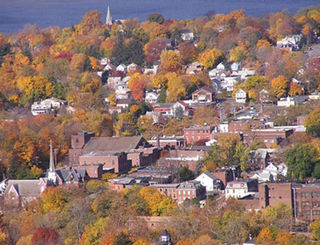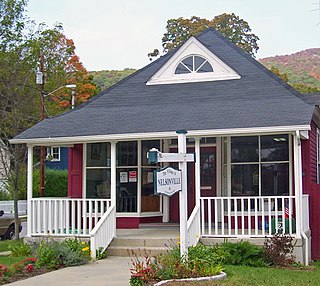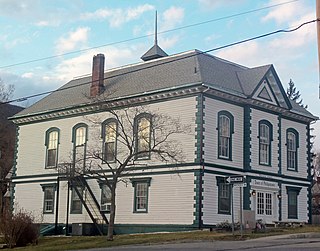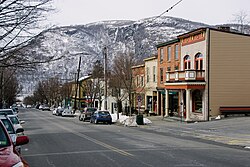
Putnam County is a county located in the U.S. state of New York. As of the 2020 census, the population was 97,668. The county seat is Carmel, located within one of six towns comprising the county. The county is part of the Hudson Valley region of the state.

Beacon is a city located on the Hudson River in Dutchess County, New York, United States. As of the 2020 census, the city's population was 13,769. Beacon is part of the Kiryas Joel–Poughkeepsie–Newburgh Metropolitan Statistical Area as well as the larger New York–Newark–Bridgeport, New York–New Jersey–Connecticut–Pennsylvania Combined Statistical Area.

Wappinger is a town in Dutchess County, New York, United States. The town is located in the Hudson River Valley region, on the eastern bank of the Hudson River. The population was 28,216 at the 2020 census. The name is derived from the Wappinger Native Americans who inhabited the area. Wappinger comprises three-fourths of the incorporated village of Wappingers Falls, several unincorporated hamlets such as Chelsea, Diddell, Hughsonville, Middlebush, Myers Corners, New Hackensack, and Swartwoutville, and a number of neighborhoods.

Wappingers Falls is a village in the towns of Poughkeepsie and Wappinger, in Dutchess County, New York, United States. As of the 2010 census it had a population of 5,522. The community was named for the cascade in Wappinger Creek. The Wappingers Falls post office covers areas in the towns of Wappinger, Poughkeepsie, Fishkill, East Fishkill, and LaGrange. This can result in some confusion when residents of the outlying towns, who do not live in the village, give their address as "Wappingers Falls".

Town of Kent is a town in Putnam County, New York, United States. The population was 12,900 at the 2020 census. The name is that of an early settler family. The town is in the north-central part of the Putnam County. Many of the lakes are reservoirs for New York City.

Nelsonville is a village located in the town of Philipstown in Putnam County, New York, United States. The population was 624 at the time of the 2020 census.

Philipstown is a town located in the western part of Putnam County, New York, United States. The population was 9,831 at the 2020 census.

Fishkill is a town in the southwestern part of Dutchess County, New York, United States. It lies approximately 60 miles (97 km) north of New York City. The population was 24,226 at the 2010 census. Fishkill surrounds the city of Beacon, and contains a village, which is also named Fishkill.

Hudson Highlands State Park is a non-contiguous state park in the U.S. state of New York, located on the east side of the Hudson River. The park runs from Peekskill in Westchester County, through Putnam County, to Beacon in Dutchess County, in the eastern section of the Hudson Highlands.

New York State Route 301 (NY 301), also known as the Hudson River Turnpike, is an intra-county state highway stretching across three-quarters of Putnam County, New York, in the United States. The western terminus of NY 301 is at an intersection with NY 9D in Cold Spring. Its eastern terminus is at a junction with NY 52 in Carmel. Along the way, NY 301 meets U.S. Route 9 (US 9) and the Taconic State Parkway and passes through Clarence Fahnestock State Park. The section of the route between NY 9D and US 9 is ceremonially designated as the Sergeant Albert Ireland Memorial Highway.

New York State Route 9D (NY 9D) is a north–south state highway in the Hudson Valley region of New York in the United States. It starts at the eastern end of the Bear Mountain Bridge at an intersection with U.S. Route 6 (US 6) and US 202 in Westchester County, and follows the eastern shore of the Hudson River for 25.21 miles (40.57 km) to a junction with US 9 north of the village of Wappingers Falls in Dutchess County. While US 9 follows a more inland routing between the bridge and Wappingers Falls, the riverside course of NY 9D takes the route through the village of Cold Spring and the city of Beacon.

Gouverneur Kemble was an American diplomat, industrialist, and two-term United States Congressman from New York from 1837 to 1841.

The Wappinger were an Eastern Algonquian Munsee-speaking Native American people from what is now southern New York and western Connecticut.

Daniel Nimham was the last sachem of the Wappinger people and an American Revolutionary War combat veteran. He was the most prominent Native American of his time in the lower Hudson Valley.

The Church on the Hill is located just outside that village on Main Street in Nelsonville, New York, United States. It is the oldest church in the town of Philipstown, which includes both villages, and has been in use continually since its 1831 construction. Its white steeple, at the rise on the line between the villages, is a Nelsonville landmark. The parsonage located on Parsonage Street in Cold Spring is also owned by the church and on the National Historic Registry.

Chelsea is a hamlet of the Town of Wappinger in Dutchess County, New York, United States. It is located on the Hudson River in the southwestern corner of the town. It takes the ZIP Code 12512 and is in the 845 telephone area code, and has its own fire district.
The Hudson Highlands Multiple Resource Area is a Multiple Property Submission study supporting multiple listings in 1982 to the United States National Register of Historic Places. It originally included 58 properties spread over the counties of Dutchess, Putnam, Westchester, Orange and Rockland.

The Philipse Patent was a British royal patent for a large tract of land on the east bank of the Hudson River about 50 miles north of New York City. It was purchased in 1697 by Adolphus Philipse, a wealthy landowner of Dutch descent in the Province of New York, and in time became today's Putnam County.

Mount Nimham is a 1,273-foot-tall (388 m) mountain in Hudson Highlands of New York. It is located northwest of Carmel in Putnam County. Nimham Mountain is named after Chief Daniel Nimham of the Wappinger tribe. In 1940, an 82-foot-6-inch-tall (25.15 m) steel fire lookout tower was built on the mountain. The tower ceased fire lookout operations at the end of the 1988 fire lookout season and was officially closed the next year. The tower appears on the National Historic Lookout Register and is still open to the public.

North Highlands is a hamlet in Putnam County, New York which consists of the northernmost portions of Philipstown in the Hudson Highlands. Like the adjacent village of Nelsonville, it shares a ZIP Code and school district with nearby Cold Spring.
























